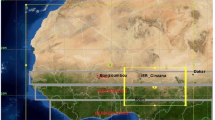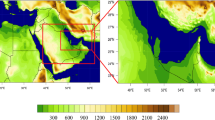Abstract
Aerosol distribution over the Arabian Sea and the Indian subcontinent during the northern hemispheric summer is dominated by mineral dust transport from the West Asian desert regions. The radiative impact of these dust plumes is expected to have a prominent role in regulating the Asian Summer Monsoon circulation. While satellite observations have provided information in the spatial distribution of aerosols over the oceanic regions during the season, their utility over the land is rather limited. This study examines the transport of mineral dust over the West Asian desert, the Indian subcontinent and the surrounding oceanic regions during the summer monsoon season with the help of a regional scale model, WRF-Chem. Geographical locations of prominent dust sources, altitude ranges of mineral dust transport and their inter-annual variations are examined in detail. Multi-year model simulations were carried out during 2007 to 2012 with a model integration from 15 May to 31 August of each year. Six-year seasonal mean (June to August) vertically integrated dust amount from 1000 to 300 hPa level shows prominent dust loading over the eastern parts of Arabian desert and the northwestern part of India which are identified as two major sources of dust production. Large latitudinal gradient in dust amount is observed over the Arabian Sea with the largest dust concentration over the northwestern part and is primarily caused by the prevailing northwesterly wind at 925 hPa level from the Arabian desert. The model simulations clearly show that most of the dust distributed over the Indo-Gangetic plane originates from the Rajasthan desert located in the northwestern part of India, whereas dust observed over the central and south peninsular India and over the Arabian Sea are mainly transported from the Arabian desert. Abnormal dust loading is observed over the north Arabian Sea during June 2008. This has been produced as a result of the low pressure system (associated with the onset of summer monsoon) which entered in to the Arabian land mass, resulting strong wind and large dust storms over the region; the prevailing northwesterly wind transported these dust in to the Arabian Sea.









Similar content being viewed by others
References
Aloysius M, Sijiikumar S, Prijith SS, Mohan M, Parameswaran K (2011) Role of dynamics in the advection of aerosols over the Arabian Sea along the west coast of peninsular India during pre-monsoon season: A case study based on satellite data and regional climate model. J Earth Syst Sci 120(2):269–279
Choobari OA, Zawar-Reza P, Sturman A (2013) Simulation of the spatial distribution of mineral dust and its direct radiative forcing over Australia. Tellus B 65(19):856. doi:10.3402/tellusb.v65i0.19856
Forster P, Ramaswamy V, Artaxo P, Berntsen T, Betts R, Fahey DW, Haywood J, Lean J, Lowe DC, Myhre G, Nganga J, Prinn R, Raga G, Schulz M, Dorland RV (2007) Changes in atmospheric constituents and in radiative forcing. In: Solomon S, Qin D, Manning M, Chen Z, Marquis M, Averyt KB, Tignor M, Miller HL (eds) Climate change 2007: the physical science basis: Working Group I Contribution to the Fourth Assessment Report of the Intergovernmental Panel on Climate Change, pp 129–234
Gadgil S (2003) The Indian monsoon and its variability. Annu Rev Earth Planet Sci 31:429–467
Ginoux P, Chin M, Tegen I, Prospero J, Holben B, co authors (2001) Sources and distributions of dust aerosols simulated with the GOCART model. J Geophys Res 106(D17):20255–20273. doi:10.1029/2000JD000053
Grell GA, Peckham SE, Schmitz R, McKeen SA, Frost G et al (2005) Fully coupled online chemistry within the WRF model. Atmos Environ 39(37):6957–6975
Huang J, Minnis P, Yi Y, Tang Q, Wang X, Hu Y, Liu Z, Ayers K, Trepte C, Winker D (2007) Summer dust aerosols detected from CALIPSO over the Tibetan Plateau. Geophys Res Lett 34(18). doi:10.1029/2007GL029938
Huang J, Minnis P, Chen B, Huang Z, Liu Z, Zhao Q, Yi Y, Ayers J (2008) Long-range transport and vertical structure of Asian dust from CALIPSO and surface measurements during PACDEX. J Geophys Res 113(D23212). doi:10.1029/2008JD010620
Huang J, Fu Q, Su J, Tang Q, Minnis P, Hu Y, Yi Y, Zhao Q (2009) Taklimakan dust aerosol radiative heating derived from CALIPSO observations using the Fu-Liou radiation model with CERES constraints. Atmos Chem Phys 9(12):4011–4021
Huang J, Wang T, Wang W, Li Z, Yan H (2014) Climate effects of dust aerosols over East Asian arid and semiarid regions. J Geophys Res Atmos 119. doi:10.1002/2014JD021796
Kaskaoutis DG, Rashki A, Houssos EE, Goto D, Nastos PT (2014) Extremely high aerosol loading over Arabian Sea during June 2008: the specific role of the atmospheric dynamics and Sistan dust storms. Atmos Environ. doi:10.1016/ j.atmosenv.2014.05.012
Krishnamurti TN, Thomas A, Simon A, Kumar V (2010) Desert Air incursions, an overlooked aspect, for the dry spells of the Indian Summer Monsoon. J Atmos Sci 67:3423e3441. doi:10.1175/2010JAS3440.1
Lau KM, Kim KM (2006) Observational relationships between aerosol and Asian monsoon rainfall, and circulation. Geophys Res Lett 33(L21810). doi:10.1029/2006GL027546
Lau KM, Kim MK, Kim KM (2006) Asian summer monsoon anomalies induced by aerosol direct forcing: the role of the Tibetan Plateau. Clim Dyn 26:855–864
Manoj MG, Devara PCS, Joseph S, Sahai AK (2012) Aerosol indirect effect during the aberrant Indian Summer Monsoon breaks of 2009. Atmos Environ 60:153–163. doi:10.1016/j.atmosenv.2012.06.007
Mishra MK, Rajeev K, Thampi BV, Parameswaran K, Nair AKM (2010) Micro pulse lidar observations of mineral dust layer in the lower troposphere over the southwest coast of Peninsular India during the Asian summer monsoon season. J Atmos Solar Terr Phys 72:1251–1259. doi:10.1016/j.jastp.2010.08.012
Moorthy KK, Satheesh SK (2000) Characteristics of aerosols over a remote island. Minicoy in the Arabian Sea: optical properties and retrieved size distributions 126:81–109
Nair SK, Parameswaran K, Rajeev K (2005) Seven-years satellite observations of the mean structure and variabilities in the regional aerosol distribution over the oceanic areas around the Indian subcontinent. Ann Geophys 23:2011–2030
Nair SK, Sijikumar S, Prijith SS (2012) Impact of continental meteorology and atmospheric circulation in the modulation of Aerosol Optical Depth over the Arabian Sea. J Earth Syst Sci 121(2):263–272
Prijith SS, Rajeev K, Thampi BV, Nair SK, Mohan M (2013) Multi-year observations of the spatial and vertical distribution of aerosols and the genesis of abnormal variations in aerosol loading over the Arabian Sea during Asian Summer Monsoon Season. J Atmos Solar Terr Phys 106:105–106
Rajeev K, Parameswaran K, Meenu S, Sunilkumar SV, Thampi BV, Raju C, Jagannath KS, Mehta SK, Rao DN, Rao KG,(2008) Observational assessment of the potential of satellite-based water vapor and thermal IR brightness temperatures in detecting semitransparent cirrus. Geophys Res Lett 35(L08808). doi:10.1029/2008GL03339
Remer LA, Tanr D, Mattoo S, Chu DA, Martins JV, Li RR, Cichoku C, Levy RC, Kleidman RG, Eck TF, Vermote E, Holben BN (2005) The MODIS aerosol algorithm, products, and validation. J Atmos Sci 62:947–973
Satheesh SK, Moorthy KK, Kaufman YJ, Takemura T (2006) Aerosol optical depth, physical properties and radiative forcing over the Arabian Sea. Meteorol Atmos Phys 91:45–62
Sijikumar S, Liji J, Manjusha K (2013) Sensitivity study on the role of Western Ghats in simulating the Asian summer monsoon characteristics. Meteorol Atmos Phys 120:53–60. doi:10.1007/s00703-013-0238-8
Skamarock WC, Klemp JB, Dudhia J, Gill DO, Barker DM, Wang W, Powers JG (2005) A description of the Advanced Research WRF version 2. Tech. rep., Natl. Cent. for Atmos. Res., Boulder
Tegen I (2003) Modeling the mineral dust aerosol cycle in the climate system. Quat Sci Rev 22:1821–1834
Tyagi A, Hatwar HR, Pai DS (2009) Monsoon Report 2008. In: IMD Met Monograph Synoptic Meterology No. 7/2009, India Meterological Department
Uno I, Wang Z, Chiba M, Chun YS, Gong SL, Hara Y, Jung E, Lee SS, Liu M, Mikami M, Music S, Nickovic S, Satake S, Shao Y, Song Z, Sugimoto N, Tanaka T, Westphal DL (2006) Dust model intercomparison (DMIP) study over Asia: overview. J Geophys Res Atmos 111(D12):D12213. doi:10.1029/2005JD006575
Vinoj V, Rasch PJ, HailongWang Yoon JH, Ma PL, Landu K, Singh B (2014) Short-term modulation of Indian summer monsoon rainfall by West Asian dust. Nat Geosci. doi:10.1038/NGEO2107
Acknowledgments
The NCEP-FNL data are obtained from http://rda.ucar.edu. The authors are thankful to the Editor and anonymous reviewers for their constructive comments.
Author information
Authors and Affiliations
Corresponding author
Additional information
Responsible Editor: B. Ahrens.
Rights and permissions
About this article
Cite this article
Sijikumar, S., Aneesh, S. & Rajeev, K. Multi-year model simulations of mineral dust distribution and transport over the Indian subcontinent during summer monsoon seasons. Meteorol Atmos Phys 128, 453–464 (2016). https://doi.org/10.1007/s00703-015-0422-0
Received:
Accepted:
Published:
Issue Date:
DOI: https://doi.org/10.1007/s00703-015-0422-0




